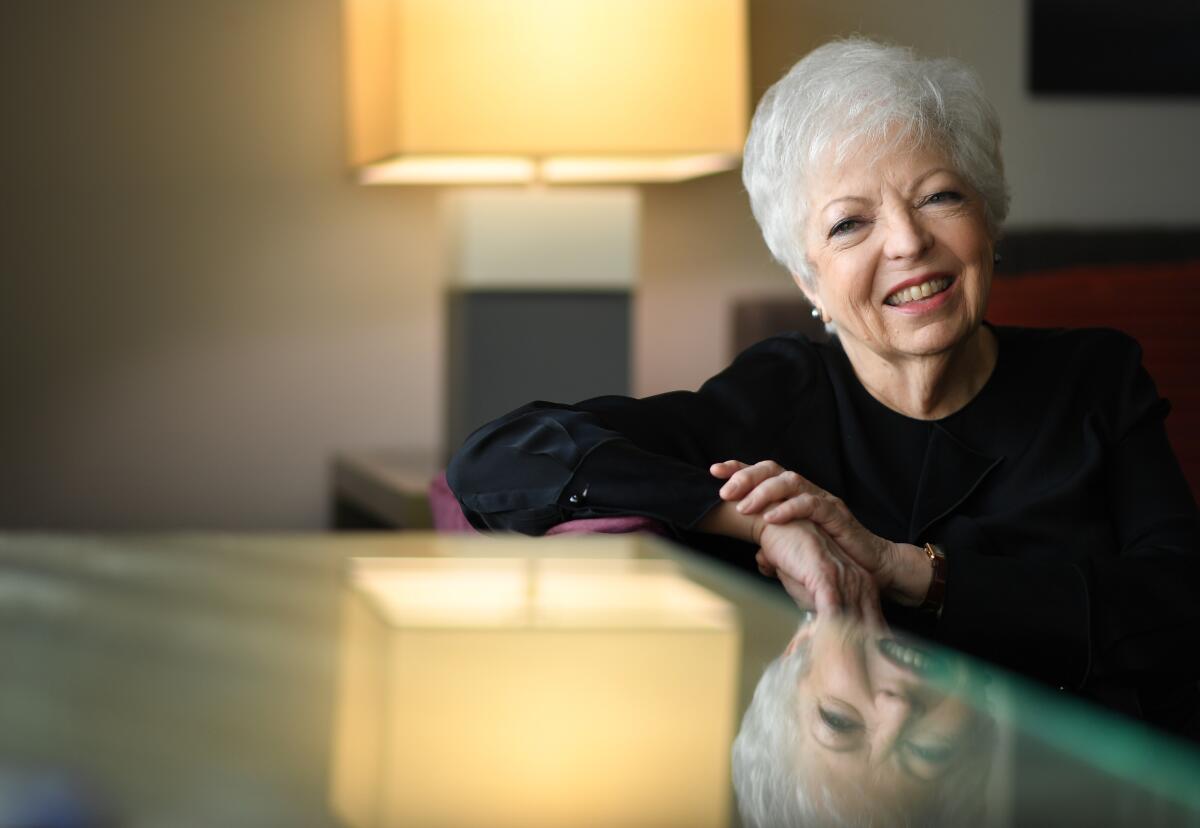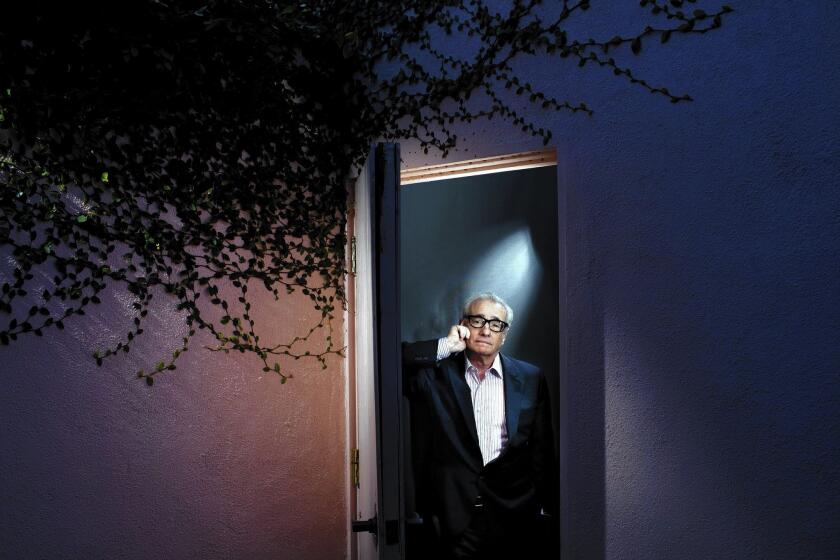Thelma Schoonmaker on editing ‘Irishman’ and her long partnership with Martin Scorsese

- Share via
“Marty and I talk about everything in the editing room — religion, politics, art, music,” says three-time Oscar-winning film editor Thelma Schoonmaker during a recent interview at the Loews Hollywood Hotel. “Marty” is, of course, Martin Scorsese, with whom she began working in 1967 and has cut all of his movies since “Raging Bull” in 1980.
“He always has Turner Classics Movies on, somewhere where I can’t see the TV screen, so it’s not distracting me. Every once in a while, he says, ‘Look at this great shot,’ or ‘Look at what this actor is going to do!’ So we watch it together, talk about it and relish it.”
Schoonmaker, whose Oscar nomination for Scorsese’s “The Irishman” is her eighth, spent some time talking about that project and her working relationship with the director.
Although “The Irishman” centers on some of Scorsese’s familiar topics, it feels different from his previous movies. What were his thoughts on how you should tackle the editing?
Marty was very explicit that he wanted the film to look and feel different. He wanted it to look deceptively simple, without flashy camera work and flashy editing. He wanted to draw the audience into an intimate connection with the movie’s characters. It seemed to have worked because we screened the movie quite a few times before we put in any of the de-aging effects, and the screening audiences didn’t mind at all that the actors were not at all young in the early scenes. When I saw the movie in a theater, you could hear a pin drop.
What would you say was your biggest challenge with this project?
The film is shot so simply. During that long drive to Detroit that starts the movie, you begin to realize that something terrible is going on, that the bosses are plotting the death of Hoffa (Al Pacino). Robert De Niro’s character is not able to hear what Joe Pesci’s character is saying in the phone booth when they stop to get gas. That creates this sense of dread. I was worried that the trip would take people out of the movie, but Marty was adamant that it wouldn’t. He didn’t even want additional sound effects like a glass being put down or people walking across the room. He said he wanted it all very truthful and stripped down.
The improvisational nature of some of the scenes plays a big part in the movie’s success. Did you have any favorites?
There was that scene that we call the pajama scene where Hoffa screams about his rival and asks [De Niro’s Sheeran] to run for office to gain control of the union. And then he expresses his love for him and hugs him. That was such a beautiful scene , and it was so unusual for Marty not to be afraid of two men in pajamas hugging. Throughout the movie, De Niro and Pesci and Pacino really listen to each other and work together in a miraculous way that you don’t see a lot.
How did the film’s innovative de-aging technology affect your work?
We cut the whole movie without it, because we don’t want to waste the time de-aging a shot, as it costs a lot of money, and then we’d have to throw it out of the movie. We waited a long time and then worked very collaboratively with Pablo Helman at ILM. He would send us [shots] and we would say, “Well, we think we lost a bit of the acting there, particularly with De Niro because his acting is so subtle in the movie: Maybe you need to put a little bit of those wrinkles back in.” Because the acting is not just in the eyes: It’s about the facial gestures and the wrinkles. They would send us the first version, we’d give them our remarks, then they’d redo it again until we got it right.
From “Taxi Driver” to “The Irishman,” Martin Scorsese has created indelible films for the American imagination. He’s not done just yet.
Do any of the scenes stand out in your memory?
I loved the salad scene, where Pesci’s character is making salads because he owns all the Howard Johnsons on that route they’re taking. In a beautiful and terrifying way, he’s telling De Niro that something has gone wrong and something has changed their minds about Hoffa. The way De Niro reacts to the news that he has to kill his best friend is incredible: He doesn’t move and you can read everything that is going through his head and heart. He is truly one of the most brilliant actors I’ve ever worked with. At the very end of that scene, you can see that he has tears in his eyes. Then, there is that incredible shot in the plane and De Niro is thinking about what he has to do, and we held on to that shot on him longer than we would normally do in an editing rhythm, because it was so brilliant.
What is your take on today’s digital editing technology?
For this film, because we had the de-aging process, we had two 3-D infra-red cameras on either side of Scorsese’s lens. We had to do 70% digital and 30% film. But our ratio is usually much higher on film. I hated to learn editing on digital at first. I loved editing on film, but I soon came to see that I can do things [that way] that I could never do on film. For example, we used to have to wait a week until we got a dissolve from an optical house. Now I do it in two seconds. I can speed up or slow down a shot, I can change the color, I can tell my assistants to take a lamp out of a shot. They have become visual effects experts now. It’s incredibly helpful, but we still love film and we try to keep it alive as much as we can. Actually, it’s more stable as a preservation. Digital sometimes just vanishes, but film, if you keep it in proper temperature and humidity, it will last for a hundred years. It’s a tool. Great masterpieces were made in the silent era when they didn’t even have a moviola. They couldn’t even look at it until they screened it, and they made great films. It’s a tool and you have to use it properly. “Casino” was the first movie I edited digitally, and I was very grumpy about it. But I had a wonderful trainer, and finally two weeks into it, I said, “OK I get it!”
Why do you think you and Martin Scorsese work so well together?
He trained me. I didn’t know anything about editing when I met him. Of course, my taste is now his taste, but over the years it has become more of a collaboration. We don’t fight over the movie. If we feel strongly that one way is better than the other way, we screen it both ways and ask our friends what they think. It’s a very collaborative dynamic, and he says I bring out the humanity in him. When I’m in the dailies with him, he tells me everything he feels about every shot and every line that the actors utter. That’s how I begin to create the first assembly.
Do you have any tips for aspiring editors?
The most important thing you can do is look at older movies. Look at the movies that taught Scorsese how to direct, including my husband’s [Michael Powell’s] films. I hear from some film professors that some students don’t want to look at black and white movies. That’s 80 years of filmmaking with masterpiece after masterpiece in it. Don’t be afraid to make mistakes, because you learn from them. Also, the most important thing to do is go for the truth: Technological tools are just tools. You don’t want to overuse technology, zoom ins and fast cuts, if the subject doesn’t call for that. That’s why “The Irishman” is made the way it is. Be truthful to the material. Let the director see the movie the way he thought of it first. Then, if you have another idea, wait a little bit and then present it to him. He’s been working on it a lot longer than you.
More to Read
Only good movies
Get the Indie Focus newsletter, Mark Olsen's weekly guide to the world of cinema.
You may occasionally receive promotional content from the Los Angeles Times.











